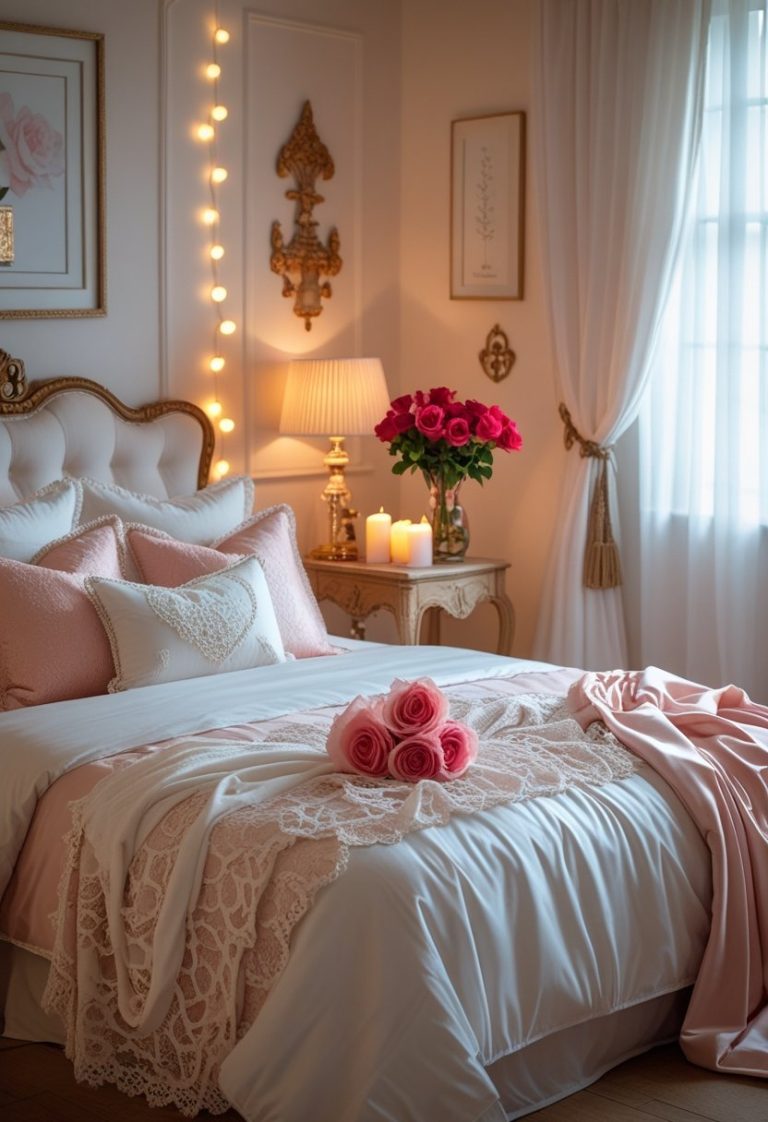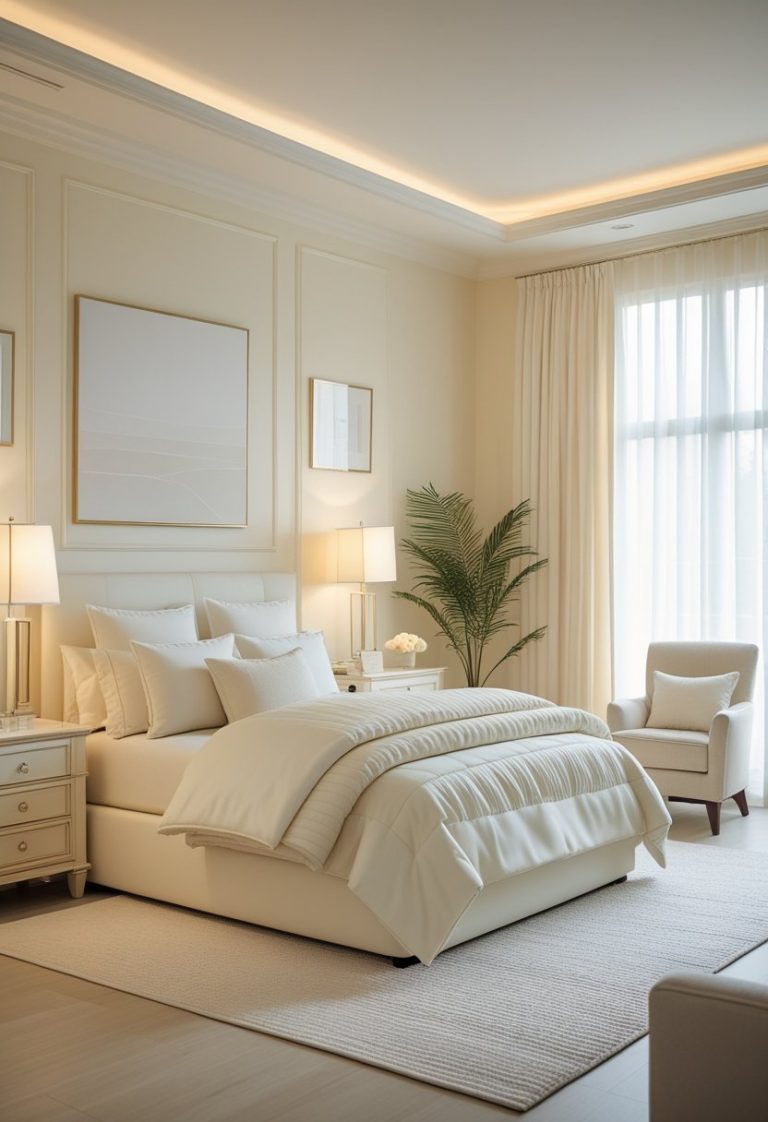Japandi Closet Ideas for Small Bedrooms With Warm Wood Tones
Transforming a small bedroom into a stylish retreat requires maximizing space without sacrificing comfort or design. This minimalist built-in closet design embraces Japandi aesthetics, combining warm wood textures with soft floral accents for a balanced and inviting feel. By using sliding doors, framed wall panels, and a neutral color palette, it offers smart storage solutions that keep the room organized and visually calm.

The design fits modern apartment living perfectly, blending Scandinavian simplicity with subtle boho and biophilic elements to create a serene atmosphere. This approach emphasizes functionality alongside tranquility, making even the smallest rooms feel cozy and clutter-free.
With curated closet styling and the latest 2025 interior design trends, this built-in wardrobe idea presents a practical way to upgrade any small bedroom. It supports efficient organization while enhancing the room’s overall aesthetic appeal.
Japandi-Inspired Minimalist Built-In Closet Design

This design combines warmth and simplicity to optimize storage without overwhelming the room. It uses natural materials, clean lines, and subtle decorative accents to create a built-in closet that supports minimalist modern bedroom aesthetics while ensuring the space remains inviting and practical.
Incorporating Warm Wood Textures
Warm wood tones are central to Japandi style, bringing natural beauty and tactile comfort to a built-in closet. Using light to medium wood grains such as oak or walnut enhances the minimalist bedroom’s calming atmosphere. These textures work well on closet doors, shelving, and drawer fronts, providing a subtle contrast to neutral walls and floors.
Wood finishes should be matte or softly polished to maintain the understated elegance typical of Japandi design. Including wood in both vertical and horizontal elements adds dimension, while keeping the color palette cohesive. This approach balances Scandinavian simplicity with Japanese warmth, making the closet both functional and visually appealing.
Framed Wall Panels and Sliding Doors
Framed wall panels introduce structure and depth to the closet space without clutter. They mimic architectural elements seen in traditional Japanese interiors, emphasizing clean, defined lines. When integrated as part of the built-in storage, these panels help frame sliding doors seamlessly, adding a sculptural quality to the closet.
Sliding doors maximize space efficiency in small bedrooms by eliminating door swing, crucial for minimalist modern bedroom layouts. The design can incorporate simple frames in wood or metal to highlight the doors’ forms without distraction. Softly muted neutral tones on the panels and doors enhance visual calm while ensuring durability and ease of use.
Soft Floral Accents for Visual Interest
Soft floral accents, used sparingly, introduce gentle ornamentation to the minimalist built-in closet. These can appear in textured wallpaper panels behind shelving, delicate printed drawer liners, or subtle botanical motifs on door hardware. The goal is to add warmth and personality without disrupting the serene feel.
Choosing florals in muted, earthy colors aligns with Japandi’s natural palette and complements warm wood textures. These accents enrich the bedroom’s biophilic aspect, connecting indoors to nature while maintaining a clutter-free, organized environment. Carefully curated flourishes like these help prevent the minimalist design from feeling sterile or overly austere.
Smart Space-Saving Wardrobe Solutions
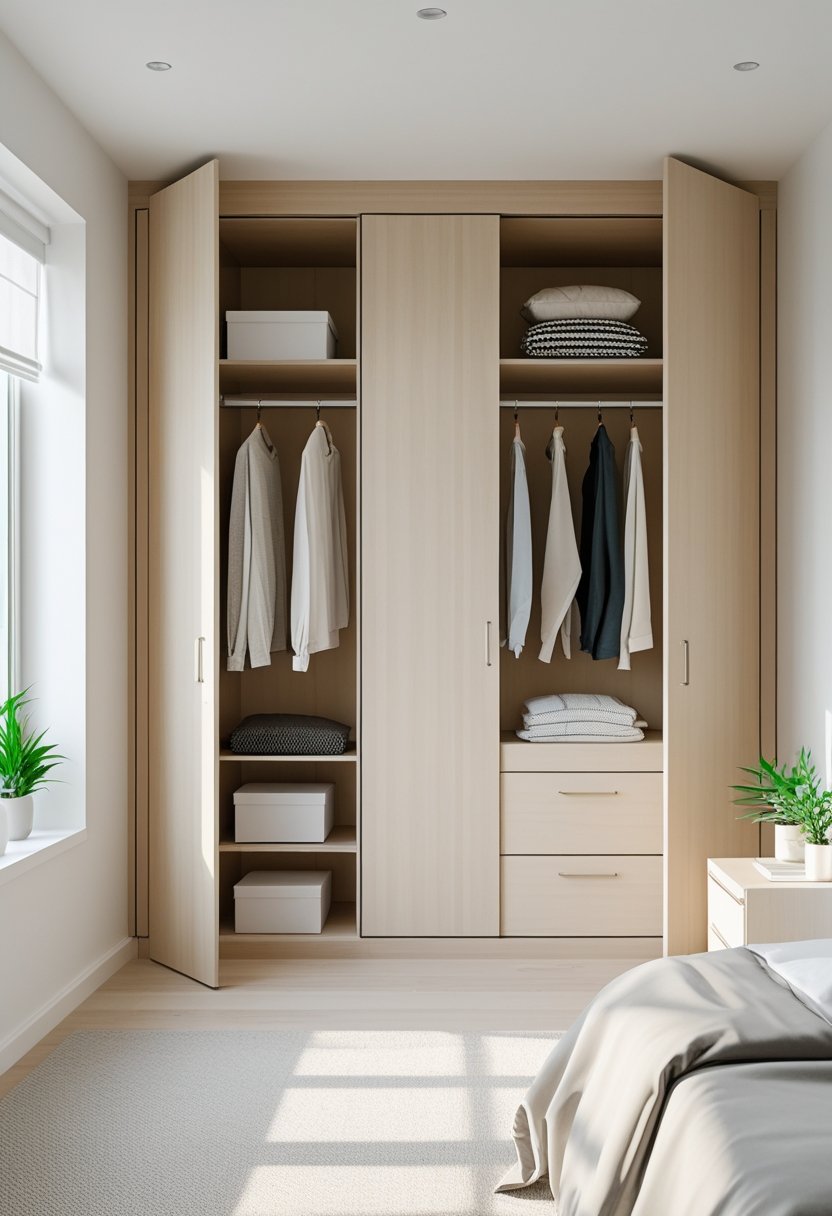
Efficient use of space and keeping the room organized are vital for small bedrooms. This includes tailored storage strategies that fit minimalist designs but still provide ample room for essentials. The focus is on clever layouts, maximize vertical areas, and blending open shelving with enclosed storage to maintain calm and order.
Maximizing Storage with Smart Organization
Smart organization leverages every inch within the wardrobe. Using adjustable shelves, dividers, and pull-out baskets creates customized compartments that make items easy to find and accessible. Grouping clothes by type and season increases efficiency and reduces visual clutter.
Incorporating slim, multi-functional hangers or hooks adds hanging space without bulk. Drawer inserts help keep small accessories tidy. Labeling or using transparent storage boxes ensures quick retrieval. This method reduces wasted room and supports maintaining a neat appearance in small bedrooms.
Space-Efficient Vertical Storage Solutions
Vertical storage solutions optimize height rather than floor area, ideal for tight spaces. Tall wardrobes with multiple shelves and hanging sections use wall height effectively. Sliding doors complement these units, saving room usually required for door clearance.
Adding overhead compartments or narrow shelves above the closet maximizes unused space, perfect for seldom-used items. Vertical rods and hooks inside the wardrobe increase storage capacity without expanding the footprint. This technique aligns with minimalist Japandi designs by keeping the area open and uncluttered.
Integrated Open Shelving for Display and Access
Open shelving within or beside the wardrobe combines storage and style. These shelves offer quick access to daily-use items like handbags, shoes, or decorative pieces. Keeping these shelves framed by wall panels helps integrate them smoothly into the design, maintaining visual harmony.
Open shelves promote a sense of airiness and complement the warm wood textures and neutral tones common in modern small bedrooms. They encourage thoughtful curation of displayed items, blending functionality with biophilic and boho influences for a cozy, inviting atmosphere.
Modern Bedroom Layout and Bed Placement

Efficient bed placement and furniture selection are crucial for maximizing space and maintaining flow in a small bedroom. Prioritizing open pathways and functional spots for storage enhances both comfort and usability.
Optimizing Bed Placement for Flow and Function
Placing the bed strategically impacts room flow and available floor space. In smaller rooms, positioning the bed in a corner can open up more usable area and create a cozy nook. Alternatively, floating the bed away from walls, especially in square rooms, can visually expand the space and create a balanced feel.
Beds with sliding door wardrobes benefit from layouts that keep closet access clear, preventing obstruction. Prioritizing natural light and sightlines by avoiding blocking windows or doorways will enhance openness.
Effective bed placement should also allow easy access from both sides when possible, improving functionality without crowding the room.
Floating Nightstands and Minimalist Furniture Choices
Floating nightstands save valuable floor space and contribute to a clean, uncluttered look. Mounted nightstands free up visual and physical room beneath, which can be used for storage baskets or kept clear for a lighter aesthetic.
Minimalist furniture with slim profiles complements a Japandi-style bedroom. Choosing pieces with warm wood tones that reflect the built-in closet’s texture maintains harmony and prevents visual clutter.
Focus on multifunctional furniture like beds with understorage drawers or compact dressers to maximize utility without overwhelming the space. Integrating soft floral accents and neutral colors keeps the environment calm and cohesive.
Layered Textures and Neutral Color Palettes
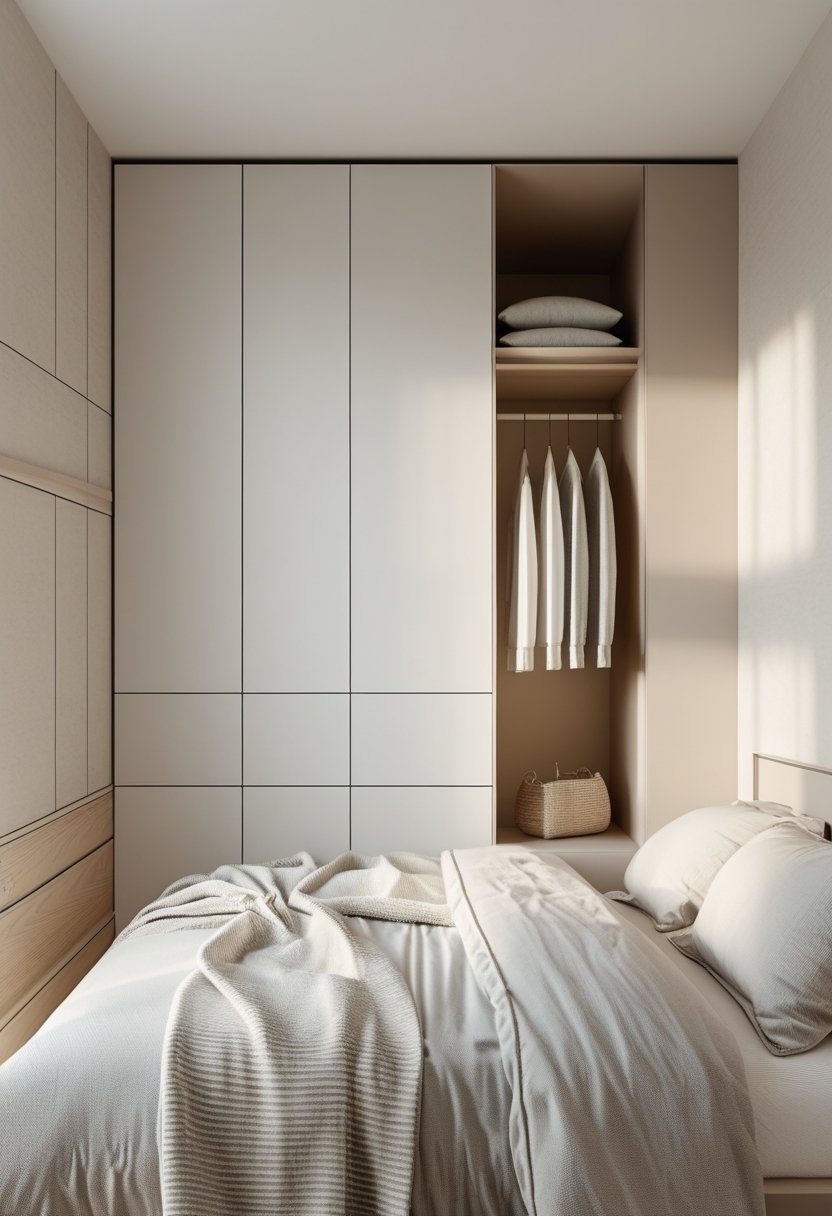
Creating a calm, cohesive space involves careful choice of subtle colors and tactile elements. The right use of light neutral tones combined with varied textures can elevate a small bedroom’s atmosphere, making it both inviting and tranquil.
Using Light and Neutral Colors for Serenity
Light and neutral colors, such as muted greys, soft beiges, and warm taupes, provide a versatile base that enhances natural light and opens up compact spaces. These colors reduce visual clutter, helping create a peaceful, airy ambiance.
Choosing wall colors, furniture finishes, and flooring in these shades supports the Japandi-inspired aesthetic, emphasizing simplicity and warmth. Using warm wood textures alongside soft neutrals maintains balance and adds subtle depth without overwhelming the senses.
Layering Throw Blankets and Accent Pillows
Incorporating layered textures through throw blankets and accent pillows brings cozy visual interest to the room. Soft knits, linen, and woven fabrics provide tactile contrast that enhances comfort while adhering to minimalist principles.
Accent pillows in subtle tones or delicate floral patterns add gentle boho touches without disrupting the calming color scheme. Varying textures—like combining smooth cotton with slightly nubby wool—creates dimension, making the bed or seating area feel inviting yet uncluttered.
Selecting White and Cream Bedding
White and cream bedding acts as a fresh, clean canvas that brightens the space. These shades are essential for maintaining a serene atmosphere and complement the other neutral tones in the room.
Choosing bedding with subtle texture—such as quilted patterns or softly crinkled linen—adds understated elegance and prevents the look from becoming too sterile. The softness of cream and white harmonizes with warm wood elements, enhancing the overall sense of comfort and style.
Strategic Lighting and Ambient Atmosphere

Effective lighting transforms a small bedroom, balancing function and mood while emphasizing minimalist design elements. Combining layered light sources, reflective surfaces, and soft textures enhances both space perception and comfort.
Incorporating Wall Sconces and Strategic Lighting
Wall sconces provide efficient, space-saving illumination that suits small bedrooms. Mounted beside or above the bed, they free up bedside table space while delivering focused light for reading or task activities. Opting for warm-toned LED bulbs maintains a cozy atmosphere without harsh glare.
Strategic placement is key. Installing sconces with adjustable arms or dimmers allows users to control brightness and direction. This versatility ensures that lighting adapts to different needs, such as winding down or preparing for the day. Additionally, pairing sconces with under-shelf or closet lighting boosts functionality in the wardrobe area without disrupting the minimalist aesthetic.
Enhancing Space with Mirrors and Sheer Curtains
Mirrors amplify natural and artificial light, making compact rooms feel larger and brighter. Positioning a tall mirror opposite a window reflects daylight deeper into the room. Framed mirrors with simple lines complement Japandi style while adding to visual interest without clutter.
Sheer curtains diffuse sunlight softly, maintaining privacy and reducing harsh shadows. Their light-filtering quality preserves the warm wood tones and floral accents within the space. Choosing neutral or pastel sheer fabrics sustains the calm, airy feel while controlling natural light flow throughout the day.
Using Ambient Lighting for a Cozy Retreat
Ambient lighting sets the bedroom’s overall tone, crucial for relaxation and comfort. Layered soft light sources, such as recessed ceiling lights combined with table or floor lamps, create warmth and depth. Lampshades in natural fibers contribute texture consistent with Japandi design.
Warm color temperatures, between 2700K and 3000K, foster tranquility. Integrating dimmable controls or smart bulbs allows for mood customization depending on time or activity. Prioritizing indirect lighting, like wall washing or uplighting, helps avoid harsh contrasts, resulting in a serene and inviting retreat environment.
Curated Closet Styling and Biophilic Decor
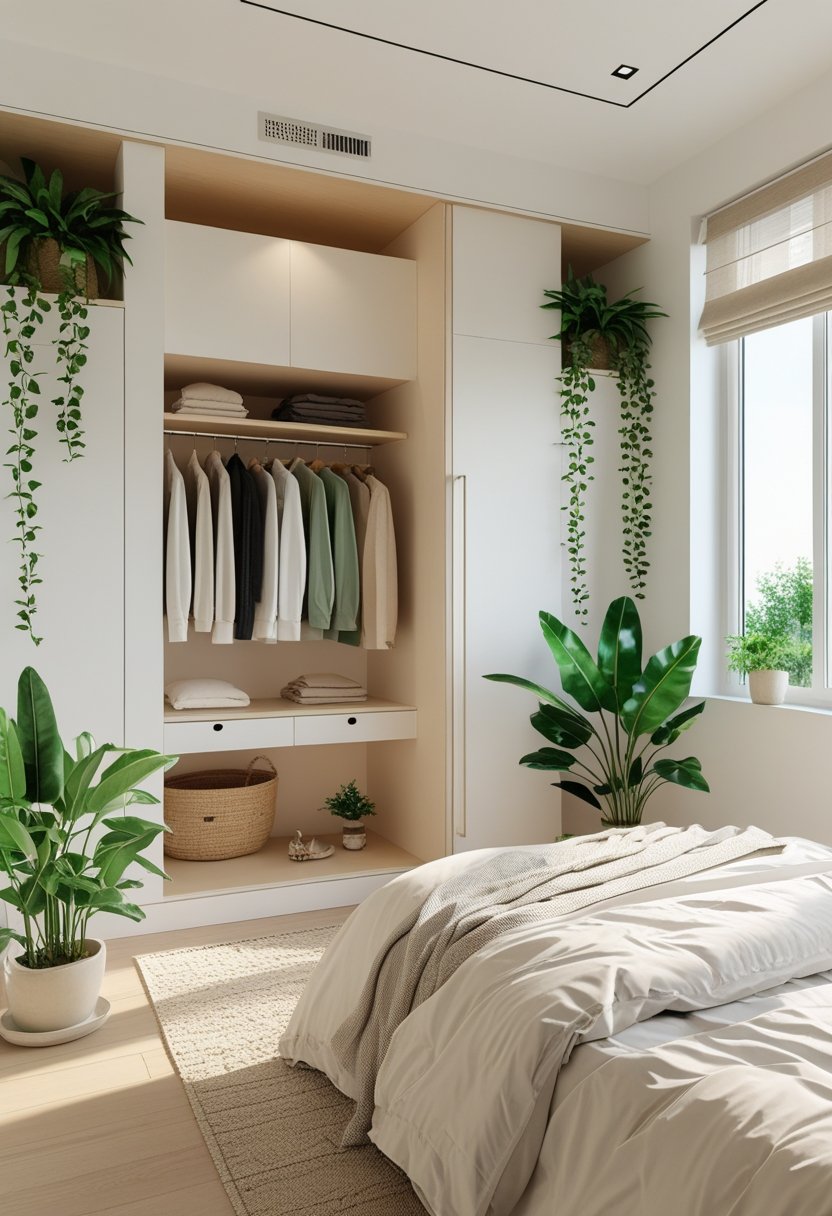
Effective closet styling balances functionality with visual appeal while maintaining a calming atmosphere. Integrating natural textures and thoughtful organization enhances both the style and usability of a small bedroom. Combining simplicity with organic materials supports a minimalist yet inviting space.
Organizing for Minimal Clutter and Calm
Maximizing storage with a built-in closet requires strategic organization to maintain a clutter-free environment. Utilizing sliding doors saves room and ensures easy access without disrupting traffic flow. Inside, modular shelving and drawer inserts help separate clothing by type, reducing visual chaos.
Incorporating labeled baskets or boxes keeps smaller items contained and encourages consistent tidiness. Installing a functional workspace within the closet, such as a compact fold-out desk or designated area for accessories, adds practical value without crowding the room. Keeping the palette neutral—white, beige, or soft gray—helps preserve a serene ambiance conducive to relaxation.
Adding Boho Touches and Natural Elements
Biophilic decor enhances the closet’s atmosphere by introducing organic textures and greenery. Warm wood tones in shelving or framed panels add tactile contrast to the sleek lines of Japandi design. Soft floral patterns in textiles or art provide subtle color without overpowering the space.
Natural materials such as jute rugs, linen drawers, or rattan baskets reinforce the connection to nature and elevate the cozy feel. Including potted plants or hanging planters near the closet area enriches air quality and visual interest. These elements transform the closet from a simple storage space into a tranquil retreat aligned with 2025’s interior trends.

Ana Luisa
Explore in-depth biographies, net worth insights, and exclusive updates on your favorite singers at Trionua.com. Discover the journeys, achievements, and latest news about music’s biggest stars.





